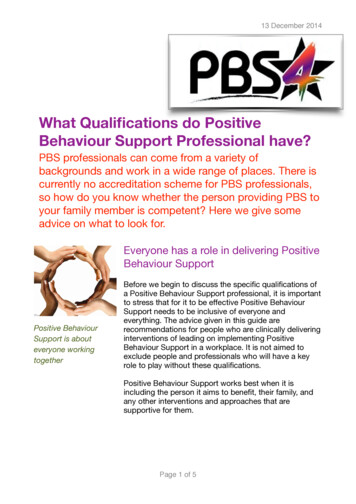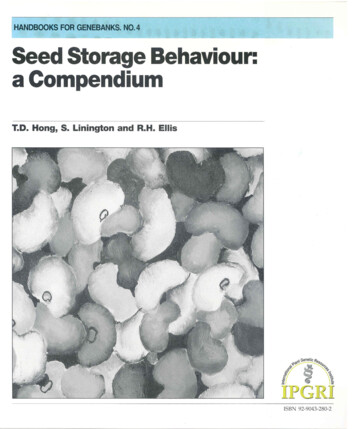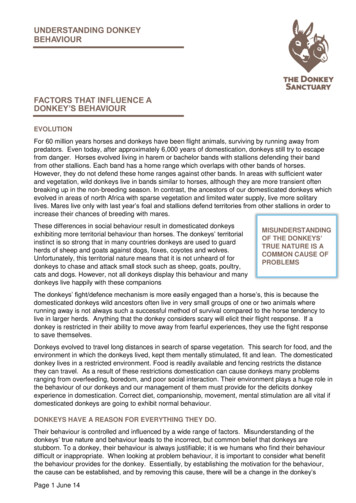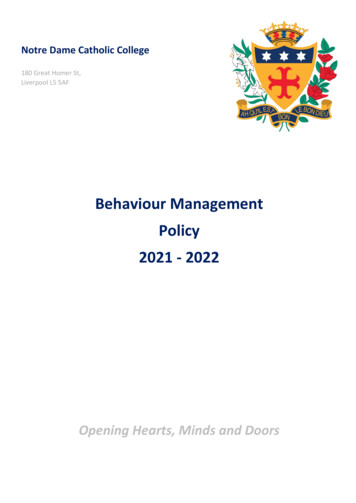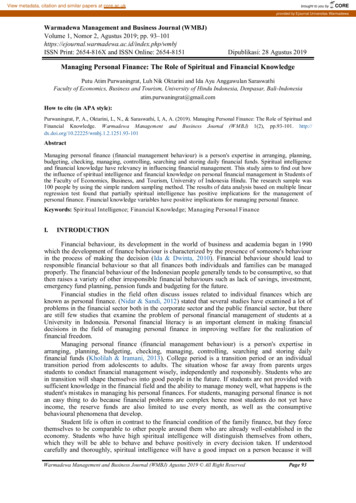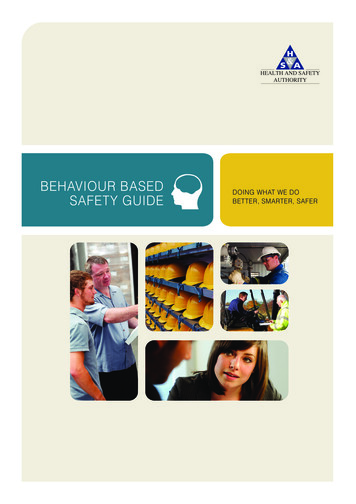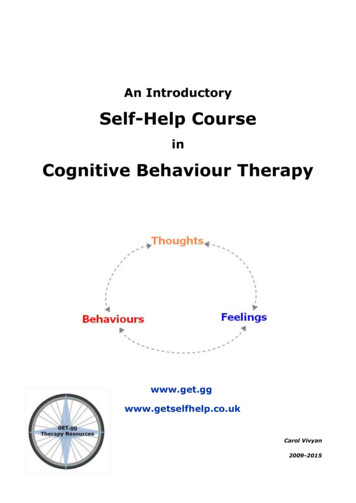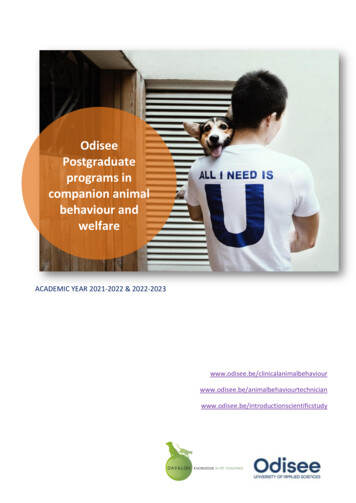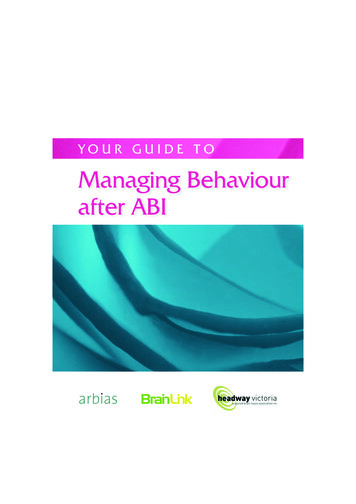
Transcription
YOUR GUIDE TOManaging Behaviourafter ABIManagingBehaviour A5 20pp.indd 112/2/08 3:09:20 PM
Managing Behaviour after ABI is part of a series of information productsabout acquired brain injury (ABI) produced by a joint committee ofbrain injury organisations with the support and assistance of theDepartment of Human Services, Victoria.To obtain further copies of this booklet or more information on ABI,contact BrainLink telephone: 03) 9845 2950 or free-call 1800 677 579or visit its website www.brainlink.org.au. If you require a languageinterpreter to speak to BrainLink on your behalf contact: Translating andInterpreting Service telephone: 131 450. This service is free of charge.Steering committee members:Merrilee CoxHeadway VictoriaSonia BertonarbiasSharon StrugnellMichelle WernerBrainLinkDepartment of Human ServicesContent:ABI Behaviour Consultancy: Suzanne Brown, Kathryn Hoskin,Editor:Lisa MitchellProject manager:Design and production:Glenn Kelly, Jan Loewy, Ann Parry, Jenny ToddThe Journey Place for Living and Learning Inc.www.mapcreative.net.auDISCLAIMERThe information in this booklet is of a general nature. Headway Victoria, BrainLink and arbias do notaccept responsibility for actions taken, or not taken, as a result of any interpretation of the contentsof this publication. 2007 Headway Victoria, BrainLink, arbias. All rights reserved. Community organisations andindividuals may copy parts of this booklet for non-profit purposes, as long as the original meaningis maintained and there is acknowledgement of the author of the publication. No graphicselements on any page of this publication may be used, copied, or distributed separately fromthe accompanying text.
CONTENTSBehaviour Change After ABI4What Causes Challenging Behaviour?6Brain injury6Environment7Personal Factors7About Behaviour Management8Managing, not fixing, behaviour8Structure8Consistency9Add positives9Seek assistance9Suggestions for Managing ChallengingManagingBehaviour A5 20pp.indd 3Behaviours10Dealing with aggression10Dealing with socially inappropriate behaviour12Dealing with inappropriate sexual behaviour14Dealing with reduced drive and initiation16Conclusion1812/2/08 3:09:24 PM
Behaviour change after ABIAcquired brain injury (ABI) occurs when the brain becomes damagedthrough trauma (falls, car accidents, fights), a stroke, infection, atumour, lack of oxygen to the brain (cardiac arrest or near drowning),through drug and alcohol abuse, or through a degenerative neurologicaldisease (Parkinsons, Alzheimer’s).Changes to a person’s behaviour are very common after ABI. These rangefrom subtle changes, such as talking too much, to markedly alteredbehaviour, such as physical aggression.Challenging behaviour can emerge or reappear at times of stress ortransition. For example, people with brain injury and their familiesoften imagine that life will return to normal when they come homefrom hospital or rehabilitation. While going home sometimes settlesbehaviour, many families report that behavioural issues become worse.There are many reasons why: Loss of routine and purpose after rehabilitation Increased stresses, such as changed finances and lifestyleadjustments Worry and depression Rising frustration as difficulties continue to surfaceThe amount of control someone with ABI has over their behaviour variesgreatly from person to person. Some people exhibit the same kind ofbehavioural issues, no matter where they are or who they are with.Others are able to keep themselves in check with friends, their boss orpeople down the street, but “lose it” when they get home. Sometimesthose closest to a person with an ABI bear the brunt of their anger andfrustration.This booklet provides introductory information, real-life case studies andsuggestions for managing challenging behaviour.4M A NAGING BEH AVIOUR A FTER A BIManagingBehaviour A5 20pp.indd 412/2/08 3:09:24 PM
Behaviour may be considered “challenging” when it occurs at the wrongtime or place, causes distress, gets people into trouble, is against the rules,or limits opportunities.The most common types of challenging behaviour include: Verbal aggression – swearing in front of the boss, shouting,threats Physical aggression – pushing, hitting, throwing objects,scratching Inappropriate sexual behaviour – sexual comments to aco-worker, touching, masturbation in public Repetitive behaviours – asking questions repeatedly, doing thesame action over and over Wandering – leaving home and getting lost Inappropriate social behaviours – refusing to shower or takemedication, demanding behaviour, failing to follow rules Risk-taking behaviour – not obeying road safety rules, excessiveuse of alcohol or drugs, arguing with the “tough” guy down atthe pub Reduced drive or difficulty initiating activities – staying in bedmost of the day, needing prompts to complete tasksM A NAGING BEH AVIOUR A FTER A BIManagingBehaviour A5 20pp.indd 5512/2/08 3:09:24 PM
What causes challengingbehaviour?Challenging behaviour after ABI is usually the result of a complexcombination of factors that relate to an individual’s brain injury, theirenvironment and personal factors.Brain injuryInjury to the brain can cause physical, emotional and cognitive(thinking) changes that influence behaviour.Physical problems: Problems with muscle weakness and coordinationcan lead to frustration and aggression if the person has no strategies tocompensate.Emotional control: After ABI, mood swings can occur and even trivialevents may trigger extreme reactions.Memory problems: Repetitive questions are common, and aggressioncan occur when the person struggles to recall information or to findsomething.Impulse control: A person with ABI may say and do inappropriate thingswithout thinking.Initiation: A lack of ‘get up and go’, difficulty generating ideas, makingplans and following through may occur. For example, despite beingbored and wanting to do something, the person stays at home doingnothing.Lack of insight: The person may deny having any significant problems,or acknowledge some problems, but have reduced awareness of theirimpact on others, daily life and future plans. They may blame theirproblems on others, refuse useful assistance, or insist that they are fineto return to work, to drive a car etc.6M A NAGING BEH AVIOUR A FTER A BIManagingBehaviour A5 20pp.indd 612/2/08 3:09:25 PM
EnvironmentEnvironmental factors, such as noise, overcrowding, rushing, or toomany things happening at once can trigger challenging behaviour in aperson with ABI.Inappropriate settings: Challenging behaviours are more likely to occurwhen people are living in a place that doesn’t suit them. For example, ayoung person living in an aged-care home.Inappropriate activities: Lack of meaningful activities, or activities notsuited to a person’s interests, can lead to boredom or frustration.Actions of others: Arguing with the person, giving in to angry demands,or paying lots of attention to inappropriate actions, can make thebehaviour worse.Personal FactorsHow someone reacts to life after brain injury will depend on theirpersonality, resilience and coping skills. Some personality traits maybecome more prominent. For example, a person who had a short fusebefore their brain injury may have temper-control problems after ABI.Psychological or psychiatric conditions: Depression, anxiety, griefand frustration over loss of one’s independence and freedom can allcontribute to challenging behaviour.General health: Illness, pain, or a bad night’s sleep can lead touncharacteristic conduct.Medication: Side effects of medication, lack of appropriate medication,alcohol and other drugs, can all affect behaviour.M A NAGING BEH AVIOUR A FTER A BIManagingBehaviour A5 20pp.indd 7712/2/08 3:09:25 PM
About behaviour managementManaging, not fixing, behaviourThe key to effective behaviour management after ABI is to managechallenging behaviour, rather than try to fix it.A person with ABI is often totally unaware of the difficulties they causeothers. Even if they do understand the impact of their behaviour, they mayno longer have the ability to change or control it.It is the people living and working with the person who are most able toadapt or change the way they do things to manage situations effectively.Peter is a young, married man who injured his brain in a fall. Afterreturning from the rehabilitation hospital, his wife, Sue, began to notice howPeter would get angry with their toddler in the evenings. Peter was an activefather before the injury and it had been his job to bathe and ready their sonfor bed while Sue cooked dinner.Initially, Sue hoped there would be a way to “fix” Peter, but over time sherealised it was easier to make changes to her own routine. She could seethat Peter was not able to cope with a tired, cranky three year-old when he,himself, was tired. She reorganised her time to prepare dinner earlier in theday, freeing herself for the bedtime routine. Peter took over dressing their sonin the mornings, when he felt more alert and energised.StructurePositive changes can be made by compensating for the part of the brainthat has been damaged. For example, frontal lobe damage often leads todifficulties with organisation and planning. To assist with this problem,families or friends can provide the structure that the person is no longerable to provide for themselves.Try developing a weekly routine that involves as little change as possibleso the person can begin to anticipate what happens next and what isexpected of them. The more severe the brain injury, the more structureis required.8M A NAGING BEH AVIOUR A FTER A BIManagingBehaviour A5 20pp.indd 812/2/08 3:09:25 PM
ConsistencyTry to ensure as much consistency as possible in how things aremanaged by family, friends and carers. The best results come froma team approach, with everyone working in the same direction, notagainst each other.Add positivesOutcomes tend to be better when positive things, such as favouritefoods and outings, are added to a situation in spite of challengingbehaviour. Withdrawing positives in a punitive way tends to lead tomore depression, anger and frustration.Seek assistanceNot surprisingly, challenging behaviour can often lead to isolation anda lack of support and understanding for people with brain injury andtheir families. This is particularly so when the behaviours are invisible’to people outside the home. Many families also struggle to come toterms with changes in their family member, and the adjustments ABIdemands of their own lives and personal relationships.It is very important to seek assistance from as many sources as possibleto manage stress and avoid burn-out. Sources might include otherfamily members, friends, health-care workers, carer-support groups andanyone who can help with activities and respite care.5 principles for effective behaviour management Manage day-to-day behaviour, rather than try to fix it Structure and routine can increase the sense of “being ontop of things” Consistency – get the “team” (family, friends etc.) moving in thesame direction, with the same expectations Add positives rather than taking them away Seek assistance from as many sources as possibleM A NAGING BEH AVIOUR A FTER A BIManagingBehaviour A5 20pp.indd 9912/2/08 3:09:25 PM
Suggestions for managingchallenging behavioursThe case studies in this section are based on real situations. We offersuggestions for managing behaviours that may be tailored to suityour needs.The most common challenging behaviours are aggression, sociallyinappropriate behaviour, inappropriate sexual behaviour and reduceddrive and initiation.Dealing with aggressionABI can damage parts of the brain that are responsible for controllingemotions. While anger and frustration are normal emotional responses,when they are expressed as verbal or physical aggression – swearing,shouting, abusive threats, hitting, pushing, assault – they are a problem.A person with ABI can have real difficulty managing their anger.Chris was 35 when a car accident left him with a brain injury thatcaused poor memory, impulsive and rigid thinking, and low frustrationtolerance. His ability to process things slowed, so it would take a while toabsorb information and to understand instructions. Chris lived with hissister, Lucy, in their family home. Lucy did all the cooking and cleaning,while Chris had little to do during the day. Lucy complained that Chriswould shout and swear at her, that he was often selfish and demanding,and that he did nothing around the house.Counselling for Chris was not useful because he could not recallthe counselling sessions, and he did not perceive that his aggressionwas a problem. At times, Chris would become enraged when peoplemisunderstood him or tried to force him to do things he did not want todo. One day, when Lucy was at the end of her tether and ready to leavehome, she yelled at Chris, telling him he was “useless” and “would benowhere” without her. Chris responded by throwing a drinking glass anda sharp knife at his sister.10M A NAGING BEH AVIOUR A FTER A BIManagingBehaviour A5 20pp.indd 1012/2/08 3:09:25 PM
Avoiding triggers: The main things that triggered Chris’s angerwere: boredom, being asked to do things he did not want to do, notunderstanding Lucy’s fast speech, and being called “useless”. Lucylearned to be more mindful of her reactions toward Chris’s behaviour.She made an effort to speak more slowly, to use calm, reassuring tones,and to keep sentences short. She tried not to remind Chris of how muchhe needed her.Avoiding battles: When Chris began shouting or swearing, Lucy learnedto walk away. She avoided raising her voice, name-calling or arguing, asthose approaches just made him angrier. If it was something important,she would bring it up later when Chris was not tired or angry.Safety: Rules were put in place to keep people safe. If Chris becamephysically aggressive, Lucy would leave the room immediately. Shewould return after about 15 minutes, when he had calmed down. Lucyfound this difficult at first but with consistent practice, she felt morein control of the situation. Glasses were replaced with plastic tumblers,and sharp knives were locked away to reduce opportunities forthrowing things.Recognising the signs: Lucy learned to recognise when Chris wasbecoming frustrated. She was able to distract him by changing thetopic, which stopped his frustration from escalating to aggression.Meaningful activities: Chris was often bored, which made him irritableand aggressive. He was referred to a case manager, who found himsome garden maintenance work, and who established more structurein his week by planning and writing down tasks, step-by-step, that Chriscould follow each day.Seeking support: Lucy attended counselling at her community healthcentre, and a carer service paid for regular respite weekends to giveher a break. A council Home Help program also assisted with weeklycleaning.M A NAGING BEH AVIOUR A FTER A BIManagingBehaviour A5 20pp.indd 111112/2/08 3:09:25 PM
Dealing with socially inappropriate behaviourSocially inappropriate behaviours are those that may be consideredannoying, intrusive, disruptive, uncooperative or unlawful. The type ofbehaviour you consider to be “challenging” depends on what is typicalfor your social circle, your levels of stress and patience, and the degreeof support you have available. Some behaviour may present a risk ordanger to self or others. Examples might include: Tactless remarks Standing too close to strangers Actively doing things to seek attention Refusing to follow toilet or shower routines Crossing roads without watching the traffic Lighting fires inappropriatelyCon is a 57 year-old man who suffered a stroke three years ago. Asa result, he developed significant memory problems, difficulties withproblem-solving, physical slowness, reduced initiation and motivation,and depression. Con’s wife, Maria, reported that he would eat the wrongfoods, refuse to exercise and refuse to shower.Con felt annoyed at Maria’s “fussing” and sometimes didn’t showerbecause he didn’t like being reminded so often. He loved all the foodshe wasn’t supposed to eat and would eat them when she had gone tobed. Maria became so anxious and stressed with his behaviour that shedeveloped high blood pressure. When they took a respite holiday however,the arguments and problems disappeared. They enjoyed the breakenormously and felt relaxed, even after returning home.Negotiation: Con and Maria made an agreement about showering,based on Con’s idea of what was practical for his lifestyle. They agreedhe would shower three times a week: Mondays, Thursdays andSaturdays. To provide Con with structure, Maria wrote a timetableof showers on his calendar, and agreed to remind him about themonly once.12M A NAGING BEH AVIOUR A FTER A BIManagingBehaviour A5 20pp.indd 1212/2/08 3:09:25 PM
Adding positives: Maria reviewed Con’s meals with a dietician so thatsnacks were a regular part of his diet, with sugar-free lollies as treats inbetween. She also adjusted the weekly shopping to include fewer of theitems that were bad for Con’s diet. Con’s day was also restructured toinclude a walk with a friend each afternoon.Respite: Respite holidays were increased to four a year to give Con andMaria something to look forward to, and to reduce stress.Seeking support: Maria attended a local carer-support group andscheduled a regular timeslot each week for an activity she wanted to do.She also had counselling to address her anxiety issues.M A NAGING BEH AVIOUR A FTER A BIManagingBehaviour A5 20pp.indd 131312/2/08 3:09:25 PM
Dealing with inappropriate sexual behaviourAfter an ABI, changes in the person’s ability to control their behaviour,and changes in how they read signals from others, can have a largeimpact on how their sexual behaviour is viewed.Some examples of inappropriate sexual behaviour include kissing,hugging and touching other people’s breasts, groins or buttocks, whenthey do not want to be touched.Sexually inappropriate behaviour does not necessarily mean that theperson needs more sex or requires a sex worker. They may want morephysical contact with others, but have limited opportunities.For people who acquire a brain injury before they reach adulthood,the social skills for forming sexual relationships are often not properlydeveloped, which often means they make clumsy sexual manoeuvres.Leon is an 18 year-old who contracted encephalitis at age 12, leavinghim with poor speech and greatly reduced mobility. Unable to care forhim, Leon’s family placed him in a group home. Leon would frequently getinto trouble for grabbing female workers’ breasts, touching their bottoms,lifting their skirts and making sexual comments to them.Leon would go home to his parents’ house on weekends, where hisdifficult behaviours continued. He would leer at his sister’s friends, makesuggestive comments to them, try to greet them with hugs, or touchtheir legs. His sister no longer felt comfortable having her friends over.Leon’s sexual behaviour didn’t seem planned however, it appeared onlyto happen when the opportunity arose. For example, touching staffinappropriately when they were serving his food, or helping Leon withshowers or dressing.Avoiding triggers: Obvious behaviour triggers were identified andworkers learned to avoid leaning directly over Leon when attending tohim and avoided turning their backs to him if within arms’ reach.A new dress code for staff excluded skirts (to avoid lifting) and tightfitting tops (to minimize targets).14M A NAGING BEH AVIOUR A FTER A BIManagingBehaviour A5 20pp.indd 1412/2/08 3:09:25 PM
Introducing consequences: Some consequences were introduced forLeon’s behaviour. Workers were trained to take a no-nonsense approachto any sexual behaviours. They would immediately tell Leon if hisbehaviour was inappropriate and suggest a better way to express apoint he wished to make, or they would leave him alone for a briefperiod before restarting their tasks.Alternative activities: Other means of non-sexual, physical contactwere explored, such as shaking hands and massage, and other means ofsexual gratification were trialled, including access to a professional sexworker and to sexually explicit videos and magazines.Learning new skills: Leon gained benefit from a social skills programat the local neighbourhood house. He practised keeping appropriatephysical distance from others, talking to others without touching themand learning which comments were not acceptable.Extended support: At home, Leon’s sister and one of her friends helpedLeon to practise by talking with him about things other than sex. Theyenforced a strict rule of “no sex talk”, and would withdraw attention fora brief time by turning or walking away if he broke the rules.Adding positives: Leon’s father began to take him bowling on Saturdays,giving his sister time to relax with friends at home. The outing was funfor Leon too, and boosted his self esteem.M A NAGING BEH AVIOUR A FTER A BIManagingBehaviour A5 20pp.indd 151512/2/08 3:09:25 PM
Dealing with reduced drive and initiationInjury to the brain can cause adynamia, a condition in which peopleexperience a lack of drive and difficulty initiating activity. A personwith adynamia has trouble getting things started or doing things forthemselves. They often appear disinterested, lethargic or uncooperative.For example, they may not wash, eat or groom themselves withoutprompting from others. They may sit on the couch all day, not startconversations, or need constant encouragement to do tasks. It oftenhelps to provide cues, structure and to develop a routine.At 46, Anna experienced a heart attack that deprived her brainof oxygen for some time (a hypoxic brain injury). After months ofrehabilitation, Anna returned home to live with her husband, Sam, andtheir two children. Since then, the family has had difficulty coping. Theycan’t get Anna to do anything. She lacks spontaneity and no longercontributes ideas to conversations. She doesn’t answer the phone if itrings, or even ask for a drink if she is thirsty. Sometimes Anna lies in bedall day, or she sits watching the television for hours on end. While she isphysically capable of doing most tasks, she often loses track of what she isdoing. For instance, she starts to go through the steps of showering, butsometimes ends up back in bed before completing the routine.Anna’s family is very distressed over all these changes. Sam sometimesfeels like Anna is being difficult on purpose and not trying hard enough.The children are really struggling to come to terms with their new’ Mum,and are starting to withdraw from meaningful contact with her.Keeping informed: Anna’s family received some education and writteninformation about adynamic behaviour and hypoxic brain injury, whichgave them a better understanding of her situation and how to assist her.Counselling: Time spent in family counselling gave Sam and thechildren some coping strategies, and addressed their grief and lossissues in relation to Anna’s condition and all their changed roles.16M A NAGING BEH AVIOUR A FTER A BIManagingBehaviour A5 20pp.indd 1612/2/08 3:09:25 PM
Enlisting support: Skilled attendant-care workers were engaged toassist Anna in developing routines and to maximise her independence,reducing some of the burden of care on her family.Improving structure: A large, visible timetable was introduced to givesome structure to Anna’s weekly activities.Mon9am wakeTue9am wakeWed9am wakeThur9am wakeFri9am ower2-4pmShoppingTime withSam2-4pmWorker: DiMake cakeCollect kids2-4pmWorker: DiShoppingCook dinner2-4pmWorker: AmyGardeningCollect kids2-4pmWorker: AmyShoppingGardeningMeaningful activities: In order to engage Anna, activities had to berelevant, meaningful to her, and easily achievable, such as cooking orwatering the garden.Motivation through encouragement: The family learned that Anna wasmore likely to follow through on tasks when praise and encouragementfor her behaviour were forthcoming.Consistency: It was important that Sam, the children and workers werepatient, persistent and consistent in maintaining routines. It took a longtime, but Anna was able to learn to use visual cues and to start doingmore things herself, with less prompting from others.M A NAGING BEH AVIOUR A FTER A BIManagingBehaviour A5 20pp.indd 171712/2/08 3:09:25 PM
ConclusionEven for experts, managing challenging behaviour is not easy, so it is notsurprising that families can find these issues particularly difficult. Still, it isimportant to remember that change and improvement can occur.Some families will find that behavioural issues are significantly improvedwith outside assistance. Others will find that with strategies in place,behavioural issues still occur, but less often or with less intensity.Behaviour management is often about finding creative ways to managethe situation you find yourself in, and not necessarily trying to “fix it”.Everyone’s situation is different, and it may take time and some trial anderror to find the right solution. Don’t be afraid to try new approaches, evenif they seem strange at first, and to seek help at any time - there are manysources of information and support available.Finally, it is important to remember that it is usually easier to change ormanage the environment and to develop coping strategies for familymembers, than it is to persist with trying to change the person with ABI.For more informationBrainLinktelephone: (03) 9845 2950 or free-call 1800 677 579website: http://www.brainlink.org.au18M A NAGING BEH AVIOUR A FTER A BIManagingBehaviour A5 20pp.indd 1812/2/08 3:09:25 PM
ManagingBehaviour A5 20pp.indd 1912/2/08 3:09:26 PM
FOR INFORMATION CALL1800 677 579BrainLinkManagingBehaviour A5 20pp.indd 2012/2/08 3:09:26 PM
Emotional control: After ABI, mood swings can occur and even trivial events may trigger extreme reactions. Memory problems: Repetitive questions are common, and aggression can occur when the person struggles to recall information or to fi nd something. Impulse control: A person with ABI may say and do inappropriate things without thinking.
